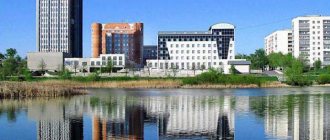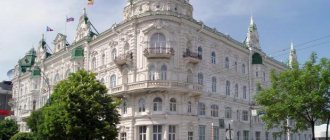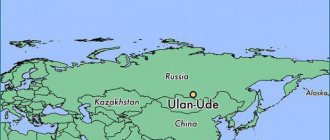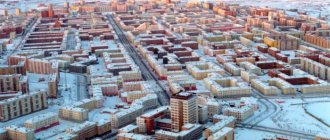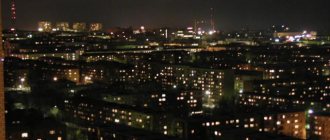The solemn date is filled with numerous events. On this day, sports competitions in football and athletics are held. Chess fans gather at the tournament. The winners receive prizes and medals. Billiards lovers can compete for the mayor's cup. Outstanding figures are awarded certificates of honor.
Dog breeders show their pets at a specialized exhibition. Walking excursions are being prepared. The guides talk about the sights and important milestones in the history of the locality. A beauty contest is being organized. Friendly matches are held between enterprise veterans. Invited popular performers take the stage. At the end of the holiday, fireworks thunder.
Prokopyevsk City Day is celebrated on the last Sunday of August. The date is fixed in the charter. In 2021, ceremonial events are held on August 29.
City information
Prokopyevsk is the administrative center of the municipal district of the same name in the Kemerovo region. Located in the south of Western Siberia. The economy is represented by enterprises of the mechanical engineering, coal mining, and food industries. There are trading and service companies.
The federal highway P384 passes near the settlement. There is a railway line. The Spichenkovo international airport is located nearby. There are vocational educational institutions and branches of universities. The population is about 200 thousand people.
Geographic information
The city is located on the banks of the Aba River (a tributary of the Tom) in the foothills of the Salair Ridge, in the southern part of Western Siberia. At a distance of 270 km to the northwest is the regional center - Kemerovo. The environmental situation, as throughout Kuzbass, is not very favorable; “black snow” due to coal dust is also not uncommon here. The area of the city is 227.5 square meters. km.
The climate in the region is sharply continental with long cold winters and short hot summers. Despite the harsh winter, the cold is tolerated quite easily due to low humidity. The average temperature in the coldest month - January - is minus 25. In the hottest month (July) - plus 19.
Story
The history of Prokopyevsk begins in the 17th century. The village of Monastyrskoye was located on the modern territory. After the construction of the church, it received the name Prokopyevskoe. Since 1911 it became the center of the volost of the same name. At the end of the 19th century, there were three large villages on the territory of Prokopyevsk.
In 1917, coal deposits were discovered here, and research began on open-pit mining. Soon the railway was built. The construction of mines began, supplying nearby enterprises with products. The village acquired the status of a working village.
On May 10, 1931, it was given city status. After the end of World War II, new production facilities were launched there. Three districts emerged: Zenkovsky, Rudnichny, Central. The city included a number of nearby settlements.
After the collapse of the USSR, the mining industry went into decline. The social sphere is dependent on city-forming companies.
Modern times
In 1920, the Sibugol enterprise was created, which began industrial coal mining. Later, a railway was built to the mines, which made it possible to quickly increase coal production. Construction of housing and social facilities has begun, schools and literacy centers have opened. In 1931, the village received city status. The population of Prokopyevsk was 54,300 people, having increased almost 5 times compared to 1926. People from all regions of the country came to work at the newly opened mines and factories under construction.
During the Soviet years, many engineering enterprises operated in the city, new residential neighborhoods, healthcare, cultural and sports facilities were built. In 1971, the population of Prokopyevsk was 273,000 people.
In post-Soviet times, the city fell into a period of protracted crisis; industrial enterprises and most mines were closed. The number of inhabitants was constantly decreasing. In 2021, the population of the city of Prokopyevsk was 196,406 people.
Flag
The flag of Prokopyevsk is made in the form of a rectangular panel with an aspect ratio of 2:3. It consists of two horizontal stripes of equal area. The top one is yellow, the bottom one is green. In the upper left corner is the city's coat of arms framed in red. Above it is the inscription “PROCOPYEVSK” in red letters. At the bottom it is decorated with a ribbon of the same color, with the number “1931” in gold.
The artistic composition was approved by decision of the Prokopyevsk City Council of People's Deputies No. 258 of April 24, 2007.
Hymn
Rising like a strong monolith Above its beautiful land, My Prokopyevsk, my beloved city, Shines as a bright, fiery star. You deployed your power and strength, the whole country learned about you. For your work - worthy rewards: The best medals, orders.
Chorus:
My Prokopyevsk is faith and hope, Father’s house and our strong stronghold, Your people, Siberian, majestic, create our future. Conquers the depths of coal and storms space and seas. My city, people are proud of you and the Russian Land is proud!
Prosper, Prokopyevsk, year after year And walk confidently into the centuries. Golden domes under the sun We are called to do good deeds. The flag flies over the clear sky - This is a symbol of peace and labor. You and I, dear, beloved city, will remain together forever!
Words by M. Kuznetsova, music by I. Bulgakov.
Approved on April 24, 2007.
Prokopyevsk
The village of Monastyrskoye is the predecessor of the city
Once upon a time, on the territory of modern Prokopyevsk there were several ancient Siberian settlements: on the site of the historical center of the city there was the village of Monastyrskaya, nearby were the large villages of Safonovo, Zenkovo, Usyaty (founded in 1784).
In 1648, not far from the Kuznetsk fort, the Nativity of Christ Monastery was founded. The peasants who worked for the monastery began to settle nearby, on the right bank of the Aba River. The settlement that arose here became known as the village of Monastyrskaya. The peasants who lived there plowed the arable land for the monastery. New settlers, impoverished peasants, came to the village, they took a loan of money, land, grain, livestock from the monastery and also began to work. The village of Monastyrskaya was created by cartographer and encyclopedist Semyon Remizov in 1699–1700.
In 1764, by decree of Catherine the Second, the Nativity of Christ Monastery was closed, and the peasants of the village of Monastyrskoye were classified as state-owned. The village was assigned to the Prokopyevsky church parish (in honor of the Holy Great Martyr Procopius), a miraculous spring was discovered in it, which was also named Prokopyevsky in honor of Saint Procopius.
The village of Prokopyevskoye in the 19th – early 20th centuries.
By the middle of the 19th century, the name Prokopyevskoye was finally assigned to the village of Monastyrskoye. In the List of populated places of the Tomsk province for 1859, Prokopyevskoye is listed as a village of the factory department of the Kuznetsk district near the Abe river. In the village there were 21 households, 140 residents of both sexes (68 males and 72 females). The Orthodox Church was active.
The famous sociologist, publicist and economist, one of the ideologists of populism V.V. Bervi-Flerovsky, who had been serving exile in Kuznetsk since 1864 and traveled a lot to the surrounding areas, left a fairly detailed description of the surrounding area and the life of the peasants. He noted the abundance of natural resources in the Kuznetsk district, the fertility of the soil on which rich vegetation grew, fragrant meadows that provided abundant feed for livestock, the presence of rich deposits of coal, iron and other metals. And “ in such a situation
“,” noted Bervi-Flerovsky, “
an unhappy and poverty-stricken population lives
.” Peasant dwellings, for the most part, were very mediocre; miserable huts without a roof were a common occurrence. Peasants could hardly protect themselves and their families from bad weather and cold. Even for the small number of livestock, the peasants often did not have enough hay, and often the livestock, due to lack of feed, died of hunger or were sold for next to nothing... A rare peasant, according to Bervi-Flerovsky, ate meat even on holidays.
According to the List of populated places of the Tomsk province for 1911, the village of Prokopyevskoye was the center of the Prokopyevskaya volost of the Kuznetsk district. The village had 157 households, in which there were 864 residents of both sexes - 443 males and 421 females. Land holdings amounted to 7,245 acres. In Prokopyevskoe there were: a church, a parochial school, a bakery store, a butter factory, and 2 manufacturing shops. Most of the village residents were descendants of settlers who settled here in the 17th–18th centuries.
In the summer of 1915, a work tent appeared at the mouth of the Povarnikhinsky log, and under the leadership of geologist L.I. Lutugin, work began on a scientific description of the new mine, which became a turning point in the fate of the future city of Prokopyevsk. In August 1915, Leonid Ivanovich Lutugin died, and search work in the area of the village of Prokopyevsk was continued by L. Lutugin’s student, V.I. Yavorsky. The scientist studied the left bank of the Aba River and in 1916 he compiled the first map of outcrops of coal seams on the surface. Also in 1916, the industrial development of the Prokopievsky coal deposit by a Franco-German-Belgian joint stock company (short for “Kuznetsk coal mines”) began.
The exploration party included former mine workers, they learned about the victory of the February Revolution and left the gold miners. They were hired in May 1917; company representatives brought them from Balyksy to Kuznetsk along the Tom River in boats, and then 30 prospectors reached Prokopyevsky on carts and immediately began geological exploration. Among the first explorers of coal from the Prokopyevskoe deposit was Georgy Blynsky. Soon, near Povarnikhinskaya Sopka, on the left bank of the Aba River, two mines and an adit were laid. On October 12, 1917, the first pounds of coal were mined, which was recorded in the “Day Book” - industrial exploitation of the deposit began.
After the October Revolution
Along the right bank of the Aba, in the place where the Koksovaya mine structures are now located, the first barracks and dugouts appear. In 1920, the Sibugol coal association was created, which included the Prokopyevsky mine, which by that time already had 8 adits. In March 1920, it was decided to open a library and reading room. In May - June 1921, on the banks of the Aba, where today the industrial site of the Central Mine is located, the foundation of the first city garden took place.
In 1921, construction of the railway line, which had begun, was resumed. On October 25, 1921, the construction of the Prokopyevsk railway line was completed, and the first train of coal departed from Prokopyevsk. The construction of the railway was the impetus for the rapid development of the mine. With access to the Trans-Siberian Railway, Prokopyevsk coal could now be delivered to numerous consumers. Many Ural factories abandoned the use of higher-cost charcoal and switched to stone.
In 1922, the first retail outlet was opened and the first electric lighting was installed. At the beginning of 1922, coal from Prokopyevsk began to be supplied to the Guryev and Nizhny Tagil metallurgical plants. By 1923, the population of the village was 6 thousand people. At this time, the first pioneer detachment was created.
In the summer of 1923, Kuzbasstrest was first allocated a state loan for the purpose of housing and communal construction. There was then about 4.5 square meters of housing per worker. By 1924, the village had 53 standard barracks, 21 adobe houses, 9 adobe half-dugouts, 197 dugouts, and 39 own houses. 4 reading huts, 11 first-level schools, 2 seven-year schools, and 9 literacy centers were opened. 37 teachers worked. In 1925, construction began on the Palace of Culture named after. Artyom. Lidia Alekseevna Fokina, a general practitioner with a university education, arrived from Tomsk.
The Soviet government established a preferential tariff for the transportation of Kuznetsk coal, which resulted in the transformation of the Urals into a large consumer of Prokopyevsk coal. In 1925, coal from Prokopyevsk began to be sent to more than 20 consumers: to Nizhne-Saldinsky, Nizhne-Tagilsky, Nevyansky, Zlatoust plants, chemical plants of Ivanovo-Voznesensk, Kemerovo and other enterprises...
In 1926, the passage of the Central adit began, the largest at that time, which became the ancestor of mine No. 3–3 bis. Radio installation work began - loudspeakers were installed in reading huts, cultural centers, and squares. In 1926, the population of Prokopyevsk reached 11 thousand people.
In 1927, the central city hospital began operating. In 1928, People's Commissar of Education Anatoly Lunacharsky visited the village. By a resolution of the All-Russian Central Executive Committee of January 29, 1928, the village of Prokopyevskoye was officially transformed into a workers' settlement with the name Prokopyevsk. The population of the village by this time reached 14,400 people.
New mines are being put into operation and the mine is developing. In 1929, a drumming competition was organized at the mine. The first youth shock brigades of Mikhail Makshantsev and Zakhar Begansky appear. The miners of the village of Prokopyevsk challenged the miners of the Leninsky mine to a competition; this competition became the first agreement on socialist competition in Kuzbass. On September 11, 1930, the first issue of the Zaboy newspaper was published (today it is Shakhterskaya Pravda).
In 1931, the miner's pick was replaced by the jackhammer. Methane gas was discovered for the first time in the mines of Prokopyevsk; in connection with this, a ventilation supervision service was created, the use of gasoline lamps was eliminated, and they were replaced with battery-powered ones.
In 1931, the population of Prokopyevsk was 54,300 people. By a resolution of the Presidium of the All-Russian Central Executive Committee of June 30, 1931, the workers' village of Prokopyevsk was transformed into a city. In August, People's Commissar Kliment Voroshilov arrived in the young city. Having descended into the lava in which the team of Ivan Akimovich Borisov, who later became the first Kuzbass Stakhanovite, worked, Voroshilov admired
In 1931, an infectious diseases hospital began operating in Prokopyevsk, for which two wooden barracks were allocated in the Izoproppunkt area. Mine No. 5-6 (later renamed in honor of K. E. Voroshilov), “Maneikha” and “Black Mountain” came into operation. In 1932, the first brick secondary school and mining technical school were opened in the city, a central mine rescue network was created, and the Ziminka 1-2 mine was put into operation. In August 1932, miners I. Latyshev and P. Neverov of mine No. 3-3 bis set a world record in coal mining with a jackhammer - they produced 82 cubic meters of coal during their shift.
On June 18, 1933, the Zenkovsky Culture and Recreation Park opened in Prokopyevsk. In August, Sergo Ordzhonikidze visited the city. In October 1933, the grand opening of the city's first sound cinema named after Robert Eikhe (secretary of the regional committee) took place, which became one of the first in Siberia. After Robert Eiche was arrested in 1938 and declared an enemy of the people, the cinema was renamed in honor of Nikolai Ostrovsky. In 1933, a water supply system began to operate in the city; the laying of pipes was carried out not only by builders, but also by ordinary citizens during subbotniks and Sundays. One of the first attractions of Prokopyevsk was the fountain on Fasadnaya Street next to the hostel. Two-story houses were erected in the city, a flower bed was laid out in the center, and maples were planted.
In March 1934, Mikhail Kalinin visited Prokopyevsk, receiving the nickname “All-Union Headman”. In April, battery repair workshops are created in the city. In the same year, mine No. 7, named after M.I. Kalinin, was put into operation. Two buses began running between Komsomolskaya Street and the station. At that time, the city had 16 km of paved roads and 10 cars.
Molotov car incident
In September 1934, the Chairman of the Council of People's Commissars, Vyacheslav Molotov, arrived in Prokopyevsk. The car in which Molotov was traveling from the station to the city pulled off to the side of the road during the journey. This incident was incriminated against the secretary of the city party committee, Alexander Yakovlevich Kurganov, and the driver of the car, V. Arnold, who were accused of attempting to organize a terrorist act. In 1937, as part of the case of the “right-Trotskyist Kuzbass bloc,” A. Kurganov was sentenced to 15 years in prison and was released only after the death of I. Stalin. V. Arnold was sentenced to 10 years in the camps, but in September 1942 he was shot.
Pre-war years
In 1935, the mine named after. Dzerzhinsky. In December of the same year, the state commission signed an act, accepting the first stage of the giant Koksovaya-1 mine. In 1936, the first music school opened. In May of the same year, the first tram appeared on the city streets. In 1937, the Maganak mine was put into operation.
By 1939, the population of the city of Prokopyevsk exceeded 107 thousand people. The Prokopyevsky mine is turning into a center for the development of coal in Kuzbass. At the same time, the Krasny Uglekop mine began operating, and in 1940, the Vostochnaya and Yuzhnaya mines began operating.
Prokopyevsk during the Great Patriotic War
On June 22, 1941, the Great Patriotic War began. A crowded meeting took place on Shakhtnaya Square, where the miners unanimously adopted a resolution - the miners will take all measures to defeat their sworn enemy, fascism. Like the whole country, the city lived under the patriotic motto: “Everything for the front!” Everything for victory!
. On July 15, 1941, the miners of the Koksovaya mine turned to the Kuzbass miners with a proposal to reorganize work in a military regime. The movement of the two hundred workers was initiated - the miners worked both for themselves and for others who had gone to the front.
In November 1941, the 376th Infantry Division was formed, which included the Prokopyevsky Regiment. Later the division was called Kuzbass, then Pskov Order of the Red Banner.
In the first year of war, a commission was created to deal with the reception and placement of evacuated enterprises and citizens. The Voronezh and Kharkov machine-building plants were evacuated to the city from the occupied territories. The Prokopyevsky Electromechanical Plant, today Elektroprom, began producing products. After the arrival of equipment from the Kharkov Lamp Plant, the production of mines, grenades and fuses was launched at the facilities of the State Union Lamp Plant (SOLKH) of the Kuznetsk Coal Combine. In 1942, on the basis of equipment evacuated from the Moscow Dukat factory and the Kyiv tobacco factory, the Prokopyevsk tobacco factory began to function. The launch of the mill-elevator machinery plant (now Prodmash) took place. Equipment from the Krasnoluchsky plant was installed in the Central Electromechanical Workshops, and thus the workshops were transformed into the Mechanical Plant.
The miners worked 10–12 hours a day. Since mid-1942, women in the coal industry made up a third of all Prokopyevsk miners. The first female miner was Alexandra Leonova, who later took the position of assistant site manager. Maria Kosogorova became the first female mine manager, heading the Ziminka mine, the workforce of which was the first in the Soviet Union to be awarded the title “Best Mine of the Soviet Union.”
For the period from 1941 to 1945. 25 million tons of coal were delivered to the mountain. All the coal was sent to metallurgists, who made armor for Soviet tanks and other weapons. Residents of Prokopyevsk collected an astronomical amount for the country's defense fund at that time - over 36.5 million rubles.
More than 17 thousand Prokopyevsk residents (according to other sources, about 18 thousand) defended their homeland from the Nazi invaders on the battlefields; 6,378 people did not return to their native Prokopyevsk. 17 residents of Prokopyevsk were awarded the title of Hero of the Soviet Union, 9 people became full holders of the Order of Glory.
Post-war years
On August 29, 1948, the first celebration of Miner's Day took place, on this day the first Heroes of Socialist Labor of Prokopyevsk received honorary titles and awards.
New mines were put into operation: in 1947 – “Northern Maganak”, in 1948 – “Zenkovskie Slopes”, in 1949 – “Krasnogorskaya”, in 1953 – “Ziminka 3-4” (now “Tyrganskaya” "), in 1956 - "Prokopyevskaya". Advanced technologies for open-pit and hydraulic coal mining are being introduced, and world records are being set among mining and mining teams. The labor glory of Prokopyevsk was increased by the Heroes of Socialist Labor: Voroshilov Kapiton Yakovlevich, Ninev Petr Ivanovich, Rozhkov Vasily Nikolaevich, Skorik Petr Iosifovich.
In 1948, production began at the State Bearing Plant No. 14. In 1951, the Palace of Pioneers opened in the city. In 1956, the hotel "opened its doors", in 1958 - the sports palace "Dolphin", the enterprise "Kholodilnik" (now OJSC "Prokopyevsky cold storage plant") began production. In 1959, a branch of the university was opened, the first in the city (now SibGIU). By order of the Council of Ministers of the RSFSR dated June 27, 1960, KuzNIIugleobogashchenie was created.
In 1964, the complex tunneling team of Nikolai Kochetkov set a world record: in 31 working days in difficult geological conditions, the team passed 1,172 meters of a two-track drift along the Bezymyanny seam at mine No. 3-3 bis.
In April 1964, the first panel house in the city was laid in the first microdistrict of Tyrgan. In 1965, the College of Physical Education opened its doors to students. Pilot-cosmonaut Alexei Leonov visited the city.
In 1971, a large-panel house-building plant (KPDS) was put into operation. In the same year, the “Chernaya Gora” mine was merged with mine No. 3-3 “bis” under the common name “Central”. In 1972, an art school opened in Prokopyevsk. In 1973, the Prokopyevsky Porcelain Factory was put into operation, and the Snezhinka Sports Palace opened its doors. In 1974, the Maneikha mine was merged with the Dzerzhinsky mine.
By the Decree of the Presidium of the Supreme Soviet of the USSR dated June 26, 1981, Prokopyevsk was awarded the Order of the Red Banner of Labor for the great successes of the city's workers in cultural and economic construction, in the development of the coal industry, as well as for its significant contribution to ensuring Victory during the Great Patriotic War.
The team of Vitaly Semenovich Kostin of the Ziminka mine in 1983, in 31 working days using an AShch-1 type unit, produced more than 35 thousand tons of coal - this was an unprecedented result in steeply dipping seams. In 1983, the team of tunnelers Yuri Borisovich Dunaev of the Central Mine carried out a three-year mining plan.
From the modern history of the city
With the beginning of perestroika in the country, difficult times began for miners. On July 13, 1989, a miners' strike began, which became massive and organized. On July 16, on the initiative of the Prokopyevsk strike committee, a regional strike committee was elected in the city, which on the night of July 17 began to draw up a package of demands that took into account the interests of both miners and all residents of Kuzbass. The July strike of 1989 lasted until July 21, some of the strikers' demands were fulfilled - the workers achieved additional pay, the regional coefficient was increased to 30%, and the miners' vacation was increased.
On September 14, 1995, an earthquake with a magnitude of 4.6 was recorded, the epicenter of which was 40 km west of Prokopyevsk.

